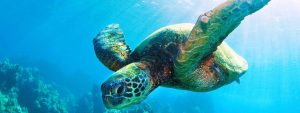Sea turtle: Interesting creature
Sea turtles are one of the Earth's most ancient creatures. The seven species that can be found today have been around for 110 million years, since the time of the dinosaurs. The sea turtle's shell, or "carapace" is streamlined for swimming through the water. Their color varies between yellow, greenish and black depending on the species. Suddenly, however, they are struggling to survive — largely because of things people are doing to the planet’s oceans and beaches. But what does this mean for the human species? It is possible that a world in which sea turtles cannot survive may soon become a world in which humans struggle to survive. If, however, we learn from our mistakes and begin changing our behavior, there is still time to save sea turtles from extinction. In the process, we will be saving one of the earth’smost mysterious and time-honored creatures. We might just be saving ourselves too.

Diet: -
What sea turtles eat depends on the subspecies, but some common items include jellyfish, seaweed, crabs, shrimp, sponges, snails, algae and mollusks.
Migration: -
Sea turtles are found in all warm and temperate waters throughout the world and migrate hundreds of miles between nesting and feeding grounds. Most sea turtles undergo long migrations, some as far as 1400 miles, between their feeding grounds and the beaches where they nest.
Behavior: -
Sea turtles spend most of their lives in the water, where not much information can be gathered on their behavior. Most of what is known about sea turtle behavior is obtained by observing hatchlings and females that leave the water to lay eggs. Sea turtles, like salmon, will return to the same nesting grounds at which they were born. When females come to the shore they dig out a nest in the ground with their back flippers, bury their clutch of eggs and return to the ocean. After hatching, the young may take as long as a week to dig themselves out of the nest. They emerge at night, move toward the ocean and remain there, solitary, until it is time to mate.
Reproduction
Temperature: Temperatures of the sand where the turtles nest determines the sex of the turtle: below 85 degrees Fahrenheit (30ºC) is predominately male; above 85 degrees Fahrenheit (30ºC) is predominately female.
Mating Season: March-October depending on the species.
Gestation: 6-10 weeks.
Clutch size: Between 70-190 eggs depending on the species.
When the young hatch out of their eggs, they make their way to the ocean. Few survive to adulthood.

Major ecological effects of sea turtle extinction:-
1. Sea turtles, especially green sea turtles, are one of the very few animals to eat sea grass. Like normal lawn grass, sea grass needs to be constantly cut short to be healthy and help it grow across the sea floor rather than just getting longer grass blades. Sea turtles and manatees act as grazing animals that cut the grass short and help maintain the health of the sea grass beds. Over the past decades, there has been a decline in sea grass beds. This decline may be linked to the lower numbers of sea turtles.
2. Beaches and dune systems do not get very many nutrients during the year, so very little vegetation grows on the dunes and no vegetation grows on the beach itself. This is because sand does not hold nutrients very well. Sea turtles use beaches and the lower dunes to nest and lay their eggs. Sea turtles lay around 100 eggs in a nest and lay between 3 and 7 nests during the summer nesting season. Dune vegetation is able to grow and become stronger with the presence of nutrients from turtle eggs. As the dune vegetation grows stronger and healthier, the health of the entire beach/dune ecosystem becomes better. Sea turtles are part of two ecosystems, the beach/dune system and the marine system. If sea turtles went extinct, both the marine and beach/dune ecosystems would be negatively affected.
Writer: -
Mohammad Saifur Rahman,
Undergraduate Student,
Institute of Marine Science & Fisheries
University of Chittagong
Ref:
1. https://getpocket.com/a/read/238964003
2. https://getpocket.com/a/read/1571730866
3. https://getpocket.com/a/read/1012347347
